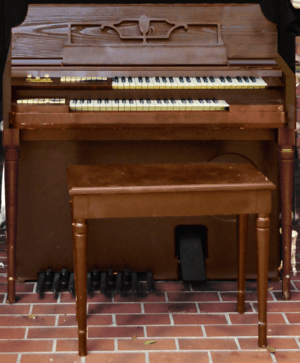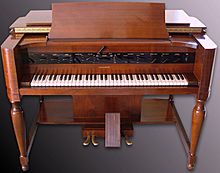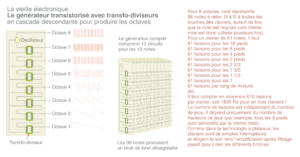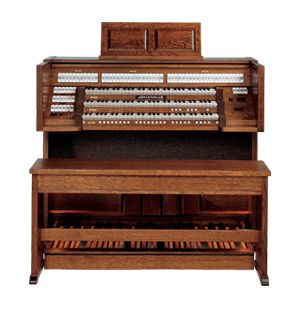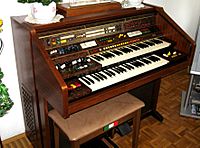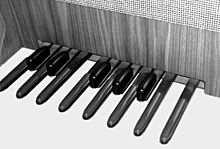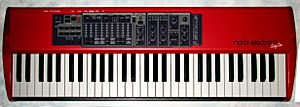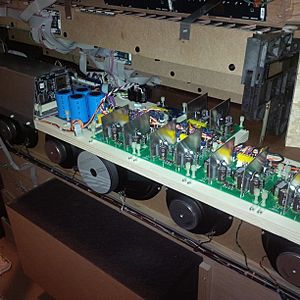Electronic organ facts for kids
An electronic organ is a keyboard instrument that works with electricity. It has developed today into two kinds of instrument:
Some electronic organs (digital organs) are made to look and sound like pipe organs. They can be used in churches and other buildings. They have some advantages over real pipe organs: they can be moved about easily, they do not go out of tune, they do not take up a lot of room (only the console and some loudspeakers are needed), and they are cheaper. They also have many computerised features which can be useful. The problems are that many people think they do not sound as good as pipe organs, and many organists think they do not feel as good to play as a traditional, mechanical pipe-organ.
The other kind of electronic organ is the one found in many homes today. It is based on the Hammond organ. The pedals are straight. It is used for jazz or popular music. Many have lots of different tone generators and synthesis modules which can imitate hundreds of instruments.
Contents
- History
- Predecessors
- Early electric organs (1897–1930s)
- Electrostatic reed organs (1934–1964)
- Electronic organs (1930s–)
- Frequency divider organs (1930s–)
- Console organs (1930s–)
- Home organs (1940s–)
- Spinet organs (1949–)
- Chord organs (1950–)
- Transistor organs (1957–)
- Combo organs (1950s–)
- Synthesizer organs (1970s–)
- Digital organs (1971–)
- Modern digital organs (1980s–)
- Software organs (1990s–)
- In churches
- Other pages
History
Predecessors
- Harmonium
The immediate predecessor of the electronic organ was the harmonium, or reed organ, an instrument that was very popular in homes and small churches in the late 19th and early 20th centuries. In a fashion not totally unlike that of pipe organs, reed organs generated sound by forcing air over a set of reeds by means of a bellows, usually operated by constantly pumping a set of pedals. While reed organs had limited tonal quality, they were small, inexpensive, self-powered, and self-contained. The reed organ was thus able to bring an organlike sound to venues that were incapable of housing or affording pipe organs. This concept was to play an important role in the development of the electric organ.
- Pipe organ
In the 1930s, several manufacturers developed electronic organs designed to imitate the function and sound of pipe organs. At the time, some manufacturers thought that emulation of the pipe organ was the most promising route to take in the development of an electronic organ. Not all agreed, however. Various types of electronic organs have been brought to market over the years, with some establishing solid reputations in their own niche markets.
Early electric organs (1897–1930s)
Electricity arrived on the organ scene in the first decades of the 20th century, but it was slow to have a major impact. Electrically powered reed organs appeared during the first decades of electricity, but their tonal qualities remained much the same as the older, foot-pumped models.
Thaddeus Cahill's gargantuan and controversial instrument, the Telharmonium, which began piping music to New York City establishments over the telephone system in 1897, predated the advent of electronics, yet was the first instrument to demonstrate the use of the combination of many different pure electrical waveforms to synthesize real-world instrument sounds. Cahill's techniques were later used by Laurens Hammond in his organ design, and the 200-ton Telharmonium served as the world's first demonstration of electrically produced music on a grand scale.
Meanwhile, some further experimentation with producing sound by electric impulses was taking place, especially in France.
Electrostatic reed organs (1934–1964)
In the wake of Hammond's 1934 invention of the tonewheel organ, competitors explored other possibilities of electric/electronic organ design. Other than the variations of tonewheel organ design, for example, a purely electronic interpretation of the pipe organ (based on "additive synthesis" design) seemed a promising approach. However, it required a huge number of oscillators, and these circuit scales and complexities were considered a technical bottleneck, as vacuum tube circuits of those days were bulky and unstable. Benjamin Miessner realized that a hybrid approach, using acoustic tone generators along with electronic circuits, could be a reasonable design for commercial products.
The Orgatron was originally developed in 1934 by Frederick Albert Hoschke, after a Miessner patent. A fan blew air over a set of free reeds, causing them to vibrate. These vibrations were detected by a number of capacitive pickups, then the resulting electric signals were processed and amplified to create musical tones. Orgatron was manufactured by Everett Piano Company from 1935 to 1941. Following World War II and a business transfer, production resumed in 1945 by the Rudolph Wurlitzer Company and continued into the early 1960s, including some models retaining the Everett name from 1945 to 1947.
Independently in Japan, a Yamaha engineer, Mr. Yamashita, invented the Yamaha Magna Organ in 1935. It was a multi-timbral keyboard instrument based on electrically blown free reeds with pickups, similar to the electrostatic reed organ developed by Hoschke a year earlier.
Electronic organs (1930s–)
On the other hand, the Hammond Novachord (1939) and other competitors selected "subtractive synthesis" design using various combinations of oscillators, filters, and possibly frequency dividers, to reduce the huge amount of oscillators which was the bottleneck on "additive synthesis" design. The heat generated by early models with vacuum tube tone generators and amplifiers led to the somewhat derogatory nickname "toaster". Today's solid-state instruments do not suffer from this problem, nor do they require the several minutes that vacuum tube organs needed to bring the filament heaters up to temperature.
Electronic organs were once popular home instruments, comparable in price to pianos and frequently sold in department stores. After their début in the 1930s, they captured the public imagination, largely through the film performances of Hammond organist Ethel Smith. Nevertheless, they initially suffered in sales during the Great Depression and World War II. After the war they became more widespread; for example, the Baldwin Piano Company introduced its first in 1946 (with 37 vacuum tubes). They peaked in popularity in the mid-1970s, by which time sales began being undercut by the rapid growth of television and high fidelity audio systems as home entertainment alternatives. Home electronic organ models usually attempted to imitate the sounds of theatre organs and/or Hammonds, rather than classical organs.
Frequency divider organs (1930s–)
Early electronic organ products released in the 1930s and 1940s were already implemented on frequency divider technology using vacuum tubes or transformer-dividers.
With the development of the transistor, electronic organs that used no mechanical parts to generate the waveforms became practical. The first of these was the frequency divider organ, the first of which used twelve oscillators to produce one octave of chromatic scale, and frequency dividers to produce other notes. These were even cheaper and more portable than the Hammond. Later developments made it possible to run an organ from a single radio frequency oscillator. Frequency divider organs were built by many companies, and were offered in kit form to be built by hobbyists. A few of these have seen notable use, such as the Lowrey played by Garth Hudson. Its electronic design made the Lowrey easily equipped with a pitch bend feature that is unavailable for the Hammond, and Hudson built a musical style around its use.
Console organs (1930s–)
Console organs, large and expensive electronic organ models, resembled pipe organ consoles. These instruments had a more traditional configuration, including full-range manuals, a wider variety of stops, and a two-octave (or occasionally even a full 32-note) pedalboard easily playable by both feet in standard toe-and-heel fashion. (Console organs having 32-note pedalboards were sometimes known as "concert organs.") Console models, like spinet and chord organs, had internal speakers mounted above the pedals. With their more traditional configuration, greater capabilities, and better performance compared to spinets, console organs were especially suitable for use in small churches, public performance, and even organ instruction. The home musician or student who first learned to play on a console model often found that [s]he could later make the transition to a pipe organ in a church setting with relative ease. College music departments made console organs available as practice instruments for students, and church musicians would not uncommonly have them at home.
Home organs (1940s–)
During the period from the 1940s through approximately the 1970s, a variety of more modest self-contained electronic home organs from a variety of manufacturers were popular forms of home entertainment. These instruments were much influenced by the theatre organ in its style, and often these stops contained imitative voicings such as "trumpet" and "marimba". In the 1950s–1970s, as technology progressed, they increasingly included automated features such as:
- One-touch chords (Hammond S-6 Chord Organ, 1950)
- Electronic rhythm (Wurlitzer Sideman, 1959)
- Repeat percussion (Thomas Organ)
- Automatic walking bass (Gulbransen)
- Arpeggiator (Hammond organ, etc.)
- Autochord (Hammond Piper, 1970)
and even built-in tape players. These features made it easier to play complete, layered "one-man band" arrangements, especially for people who had not trained as organists. The Lowrey line of home organs is the epitome of this type of instrument. While a few such instruments are still sold today, their popularity has waned greatly, and many of their functions have been incorporated into more modern and inexpensive portable keyboards.
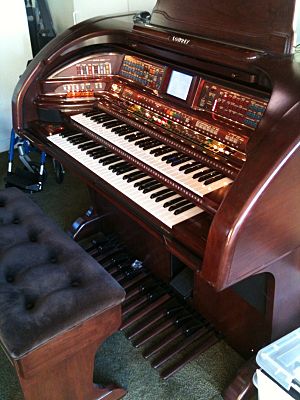
Spinet organs (1949–)
has two short manuals arranged with offset.
Following World War II, most electronic home organs were built in a configuration usually called a spinet organ, which first appeared in 1949. These compact and relatively inexpensive instruments became the natural successors to reed organs. They were marketed as competitors of home pianos and often aimed at would-be home organists who were already pianists (hence the name "spinet", in the sense of a small upright piano). The instrument's design reflected this concept: the spinet organ physically resembled a piano, and it presented simplified controls and functions that were both less expensive to produce and less intimidating to learn. One feature of the spinet was automatic chord generation; with many models, the organist could produce an entire chord to accompany the melody merely by playing the tonic note, i.e., a single key, on a special section of the manual.
On spinet organs, the keyboards were typically at least an octave shorter than is normal for organs, with the upper manual (typically 44 notes, F3–C7 in Scientific Pitch Notation) omitting the bass, and the lower manual (typically F2–C6) omitting the treble. The manuals were usually offset, inviting but not requiring the new organist to dedicate the right hand to the upper manual and the left to the lower, rather than using both hands on a single manual. This seemed designed in part to encourage the pianist, who was accustomed to a single keyboard, to make use of both manuals. Stops on such instruments, relatively limited in number, were frequently named after orchestral instruments that they could, at best, only roughly approximate, and were often brightly colored (even more so than those of theatre organs). The spinet organ's loudspeakers, unlike the original Hammond models of the 1930s and 1940s, were housed within the main instrument (behind the kickboard), which saved even more space, although they produced a sound inferior to that of free-standing speakers.
The spinet organ's pedalboard normally spanned only a single octave, was often incapable of playing more than one note at a time, and was effectively playable only with the left foot (and on some models only with the left toes). These limitations, combined with the shortened manuals, made the spinet organ all but useless for performing or practicing classical organ music; but at the same time, it allowed the novice home organist to explore the challenge and flexibility of simultaneously playing three keyboards (two hands and one foot). The expression pedal was located to the right and either partly or fully recessed within the kickboard, thus conveniently reachable only with the right foot. This arrangement spawned a style of casual organist who would naturally rest the right foot on the expression pedal the entire time, unlike classically trained organists or performers on the earlier Hammonds. This position, in turn, instinctively encouraged pumping of the expression pedal while playing, especially if already accustomed to using a piano's sustain pedal to shape the music. Expressive pumping added a strong dynamic element to home organ music that much classical literature and hymnody lacked, and would help influence a new generation of popular keyboard artists.
Chord organs (1950–)

Shortly after the debut of the spinet, the "chord organ" appeared. This was an even simpler instrument designed for those who wanted to produce an organlike sound in the home without having to learn much organ (or even piano) playing technique. The typical chord organ had only a single manual that was usually an octave shorter than its already-abbreviated spinet counterpart. It also possessed scaled-down registration and no pedalboard. The left hand operated not a keyboard but an array of chord buttons adapted from those of an accordion.
The original Hammond chord organs in 1950 were electronic instruments using vacuum-tube technology. In 1958, Magnus Organ Corporation introduced chord organs similar to an electrically blown reed organ or harmonium.
Transistor organs (1957–)
Electronic organs before the mid-1950s had used vacuum tubes which tended to be bulky and unstable. This restricted attempts to extend features and spread their use into homes. Transistors, invented at Bell Labs in 1947, went into practical production in the 1950s, and their small size and stability led to major changes in the production of electronics equipment, in what has been termed the "transistor revolution".
In 1957, a home organ manufacturer, Gulbransen, introduced the world's first transistor organ, Model B (Model 1100). Although it used transistors for tone generation, vacuum tubes were still used for amplification And in 1958, Rodgers built the first fully solid-state transistorized organ for church, called Opus 1 (Model 38). Other manufacturers followed.
Combo organs (1950s–)

By the 1960s, electronic organs were ubiquitous in all genres of popular music, from Lawrence Welk to acid rock (e.g. The Doors, Iron Butterfly) to the Bob Dylan album Blonde on Blonde. In some cases, Hammonds were used, while others featured very small all-electronic instruments, only slightly larger than a modern digital keyboard, called combo organs. (Various portable organs made by Farfisa and Vox were especially popular, and remain so among retro-minded rock combos.) The 1970s, 1980s and 1990s saw increasing specialization: both the gospel and jazz scenes continued to make heavy use of Hammonds, while various styles of rock began to take advantage of increasingly complex electronic keyboard instruments, as large-scale integration and then digital technology began to enter the mainstream.
Synthesizer organs (1970s–)
Digital organs (1971–)
Allen introduced the world's first digital organ (and first digital musical instrument commercial product) in 1971: the Allen Digital Computer Organ. This new technology was developed for use in home organs by North American Rockwell (project leader Ralph Deutsch) and licensed to Allen, which began using it for church organs. Allen later sued Rockwell and Deutsch, and gained sole rights to the digital computer organ technology.
An Eminent 310 organ was prominently featured on Jean Michel Jarre's albums Oxygène (1977) and Équinoxe (1978). The Solina String Ensemble was used extensively by pop, rock, jazz and disco artists, including Herbie Hancock, Elton John, Pink Floyd, Stevie Wonder, The Carpenters, George Clinton, Eumir Deodato, The Rolling Stones, The Buggles, Rick James, George Harrison, and The Bee Gees.
In 1980, Rodgers introduced the first church organs controlled by microprocessors, partially based on research at the University of Bradford. The university's "Bradford Computing Organ" has technological descendants in some European digital organs using synthesis technology today.
This style of instrument has also been popular with some classically trained concert organists preferring to avoid learning an unfamiliar pipe organ for every concert location, and wishing to perform in venues without pipe organs. Virgil Fox utilized a large Rodgers organ dubbed "Black Beauty" during his Heavy Organ tour during the early 1970s. From 1977 until his death in 1980, he used a custom Allen electronic organ. Carlo Curley toured with a substantial Allen Organ in the USA and with an Allen in the UK. Organist Hector Olivera has toured with a custom Rodgers instrument named "The King," and Cameron Carpenter has recently begun touring with a custom 5-manual digital organ by Marshall & Ogletree.
Modern digital organs (1980s–)
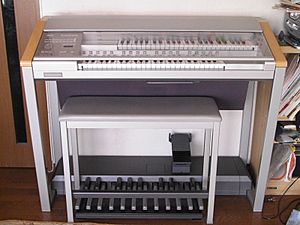
Electronic organs are still made for the home market, but they have been largely replaced by the digital keyboard or synthesizer, which is not only smaller and cheaper than typical electronic organs or traditional pianos, but also far more capable than the most-advanced electronic organs of earlier years. Modern digital organs, by the same token, are far more advanced in design and capabilities than their ancestors. Today's digital organs have reached a degree of sophistication and complexity surpassed only by the pipe organ itself, and often offer features not found in pipe organs, such as orchestral and percussion sounds, a choice of historical pitch standards and temperaments, and advanced console aids.
Today's instruments incorporate real-time tone generation (based on sampling or synthesis technologies), MIDI, and Internet connectivity for downloading of music data and instructional materials, as well as making use of USB flash drive or media card storage. While electronically they are radically different from their predecessors, their basic appearance makes them instantly identifiable as the latest generation in a long line of electronic organs that now reaches back more than eighty years.
The best digital organs of the 2000s have a number of technical features that distinguish their sound from earlier, simpler instruments: Electone Stagea EL-900m (2000) </gallery> -->
- DSP technology
In 1990, Rodgers introduced software-based digital church organs with its patented "Parallel Digital Imaging" technology, which connected multiple Digital Signal Processors (DSP chips) in parallel for fast processing to generate pipe organ sound with stereo imaging. Organ sound in most current digital organs is derived from DSPs in either a sampled or synthesis type generation system. Sampled technologies use sound files recorded from various ranks of pipe organs and then processed to be the root basis for generation of the organ sound. In synthesis systems, the wave shape is created without using an actual sample as a guide. Both systems actually generate organ tone, sometimes in stereo in better systems, rather than simply playing back recordings as a simple digital keyboard sampler might do. Marketed as a "Real Time System" by Eminent and also sold by Wyvern, Copeman Hart, Cantor, and Van der Pole in Europe, synthesis organs may use circuitry purchased from Musicom, an English supply company. In the digital organ category, synthesis-based systems are rarely seen outside of Europe.
- Sampling
Many of today's digital organs use high-quality samples to produce as accurate a sound as possible. Sampled systems may have samples of actual organ pipes for each individual note, or may use only one or a few samples which are then frequency-shifted to generate the equivalent of a 61-note pipe rank. Some digital organs like Walker Technical and the very costly Marshall & Ogletree organs use longer samples for additional realism, rather than having to repeat shorter samples in their generation of sound. Sampling in 2000s-era organs is typically done with 24-bit or 32-bit resolution, at a higher frequency than the 44,100 samples per second of CD-quality audio with 16-bit resolution.
- Surround sound
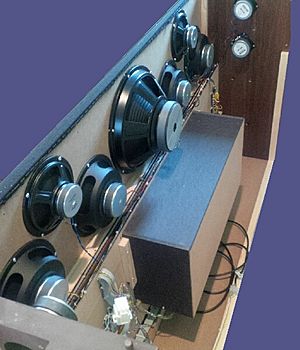
On most digital organs, several audio channels are used to create a more spacious sound. Higher-quality custom digital organ builders use custom audio and speaker systems and may provide from 8 to 32 or more independent channels of audio, depending on the size of the organ and the overall budget for the instrument. With dedicated high-power subwoofers for the low frequencies of the sound, the best digital organs can approach the physical feeling of a pipe organ if a sufficient number of subwoofers and sufficiently powerful amplifiers are used.
- Pipe organ simulations
To better imitate pipe organs, some digital organs simulate changes of windchest pressure. (In a pipe organ, the air pressure may drop slightly when many notes are sounding at once, which changes the sound of all the pipes.)
Digital organs may also incorporate simulated models of Swell boxes which mimic the environmental effects on pipes, pipe chest valve release, and other pipe organ characteristics. These effects are often added to the computer sound generation in modern digital organs to create more-realistic pipe organ tone.
Pipe sound can be simulated to include sampled or modeled room acoustic. Rodgers patented "RSS" technology, which uses binaural and transaural processing to create real-time acoustic models, and Allen's "Acoustic Portrait", purchased from Lake Industries in 2004, are examples of better-quality acoustic systems where room acoustic is part of the sound generation.
Software organs (1990s–)
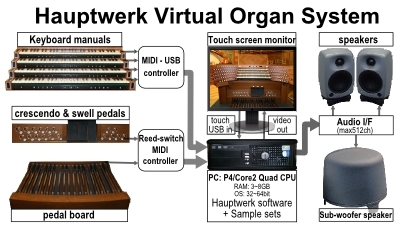 A software organ system |
The processing power of today's personal computers has brought the world of organs closer than ever before. Software applications are available that store digital pipe samples and sum them in real time in response to input from one or more MIDI sources. Some of these are Hauptwerk, MyOrgan, GrandOrgue, jOrgan, Aeolus, SCPOP, and Miditzer which emulates a Wurlitzer theatre organ. Many hobbyists have used these tools to assemble home-built organs that can rival the sound quality of commercially built digital organs at a relatively low cost.
In churches
Pipe/Electronic hybrid organs (1930s–)
Early combinations of electronic tone generators and pipe organs had been developed in the 1930s. Custom electronic organ consoles occasionally replace aging pipe consoles, thereby updating the electrical control system for the pipes as well as adding electronic voices to the organ. Today, even large pipe organs are often supplemented with electronic voices for deep bass tones that would otherwise require 16- to 32-foot pipes.
For hybrid organs that combine pipes and electronic sounds, an important issue is that pipes change pitch with environmental changes, but electronic voices do not follow by default. The frequency of sound produced by an organ pipe depends on its geometry and the speed of sound in the air within it. These change slightly with temperature and humidity, so the pitch of an organ pipe will change as the environment changes; therefore the pitch of the electronic side in a hybrid instrument must be re-tuned as needed. The simplest way this can be done is with a manual control that the organist can adjust, but some recent digital models can make such adjustments automatically.
Electronic church organs (1939–)
The first full electronic church organ was built in 1939 by Jerome Markowitz, founder of the Allen Organ Company, who had worked for years to perfect the replication of pipe organ sound through the use of oscillator circuitry based on radio tubes. In 1958, Rodgers Organ Company built the first solid-state, transistorized church organ, its three-manual Opus 1.
In contrast to frequency divider circuitry with only a few independent pitch sources, quality electronic church organs have at least one oscillator per note and often additional sets to create a superior ensemble effect. For instance, Rodgers Opus 1 featured eight sets of transistorized pitch generators. Even today, digital organs use software-based digital oscillators to create large numbers of independent pitch and tone sources to better simulate the effect of a large pipe organ.
Digital church organs (1971–)
These are instruments designed as pipe organ replacements or as digital consoles to play existing pipes. They have developed greatly over the last two decades, and are now a common alternative to the pipe organ, particularly in churches. The technology has advanced to such a level that there are often just minor differences in sound timbre between piped and pipeless instruments, although this is still debated by organists who argue that there is no substitute for a real pipe organ. However, many churches that are unable to afford pipe organs have turned to less-expensive electronic organs as a viable alternative. Even a congregation that could afford a modest pipe organ may instead opt for a digital organ simulating a pipe organ that would be larger than they could afford or physically accommodate.
Digital organs have also become a viable alternative for churches that may have had a pipe organ and can no longer afford to maintain it, or for those situations where a pipe organ is not financially possible. Some proponents of pipe organs maintain that digital organs should be regarded as no more than multi-note hi-fi systems, only as durable as standard electronic equipment; while pipe organs, on the other hand, might still be playing without major rebuilding for many decades. Indeed, many fine pipe organs in Europe are centuries old; few electronic organs anywhere are still in service after 50 years, which is not surprising given most electronic organs are less than 50 years old. The high initial cost of pipe organs has limited their production, and all-digital and pipe/digital hybrid organs now significantly outsell pipe organs. An additional factor in the popularity of electronic organs is the small number of pipe organ dealers. Many churches are hundreds of miles from dealers capable of selling, installing and servicing pipe organs. Electronic organs are simple and inexpensive compared to pipe organs and a professional electrician can easily install and connect the components.
Most of the current digital church organs produce sounds based on recorded pipe sampling, although some including Eminent model the pipe sound by Additive synthesis. Modelling the sound is done by a professional organ "voicer", who finishes the organ in its location, much like the process of regulating and voicing a pipe organ. These organs also use very high-quality custom-designed audio systems. The builders of both custom and factory digital church organs include the firms of Ahlborn-Galanti, Allen, Eminent, Johannus, Makin, Rodgers, Viscount, and Wyvern.
Other pages




